Higher National Diploma in Business: Management and Operations Report
VerifiedAdded on 2022/12/28
|11
|3705
|66
Report
AI Summary
This report provides a comprehensive analysis of management and operations, focusing on the case of TESCO Plc. It begins by defining and comparing the roles and characteristics of leaders and managers, examining their application in various situational contexts. The report then delves into different leadership theories, including situational, systems, and contingency approaches, and their practical implementation within TESCO. Part 2 shifts the focus to operational management, explaining key approaches and the roles of leaders and managers in achieving business objectives. It assesses the factors within the business environment impacting operational management and decision-making. The report highlights the importance of operational functions such as raw material to finished product and inventory management, with an emphasis on quality control and employee engagement. The report concludes by summarizing the key findings and implications for effective management and operations within the context of TESCO.
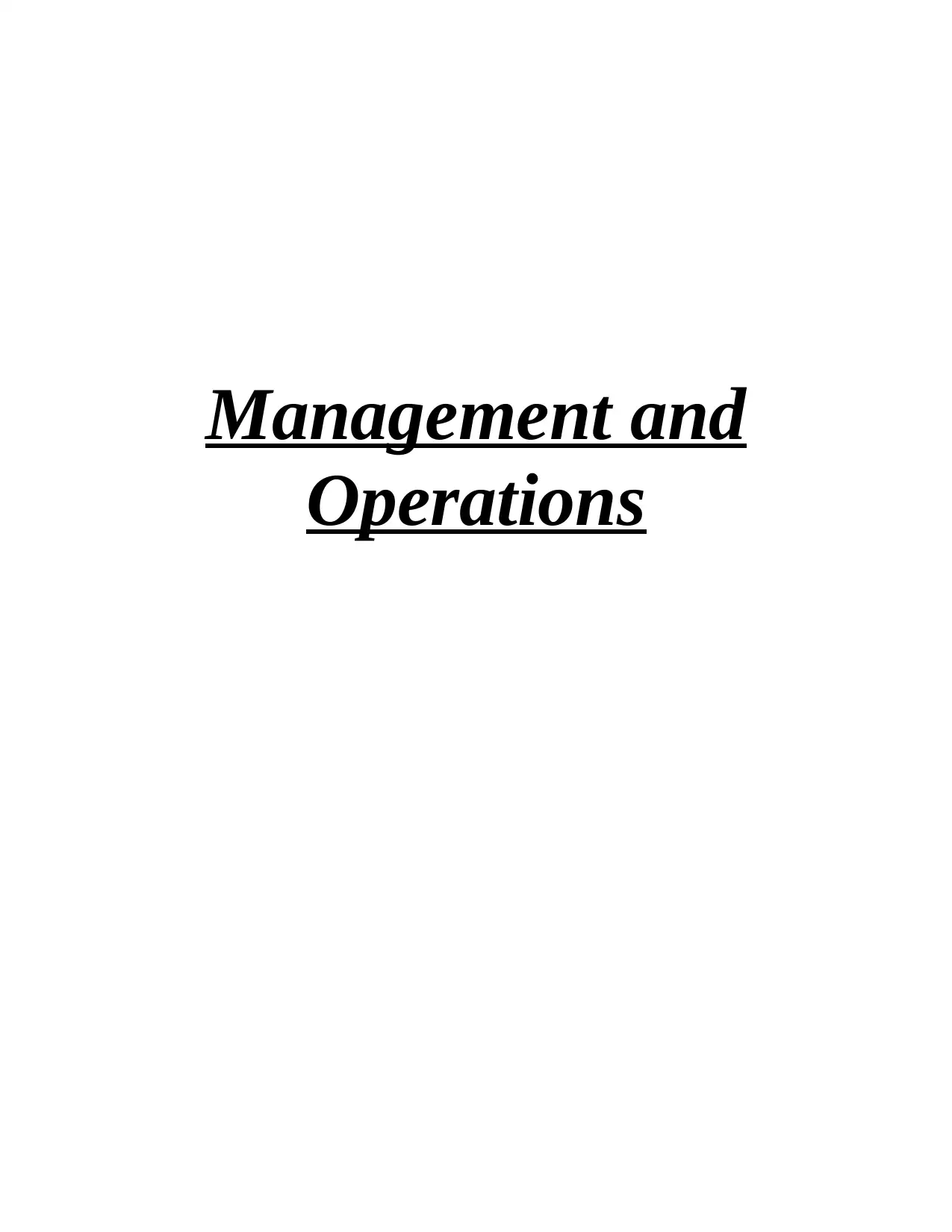
Management and
Operations
Operations
Paraphrase This Document
Need a fresh take? Get an instant paraphrase of this document with our AI Paraphraser
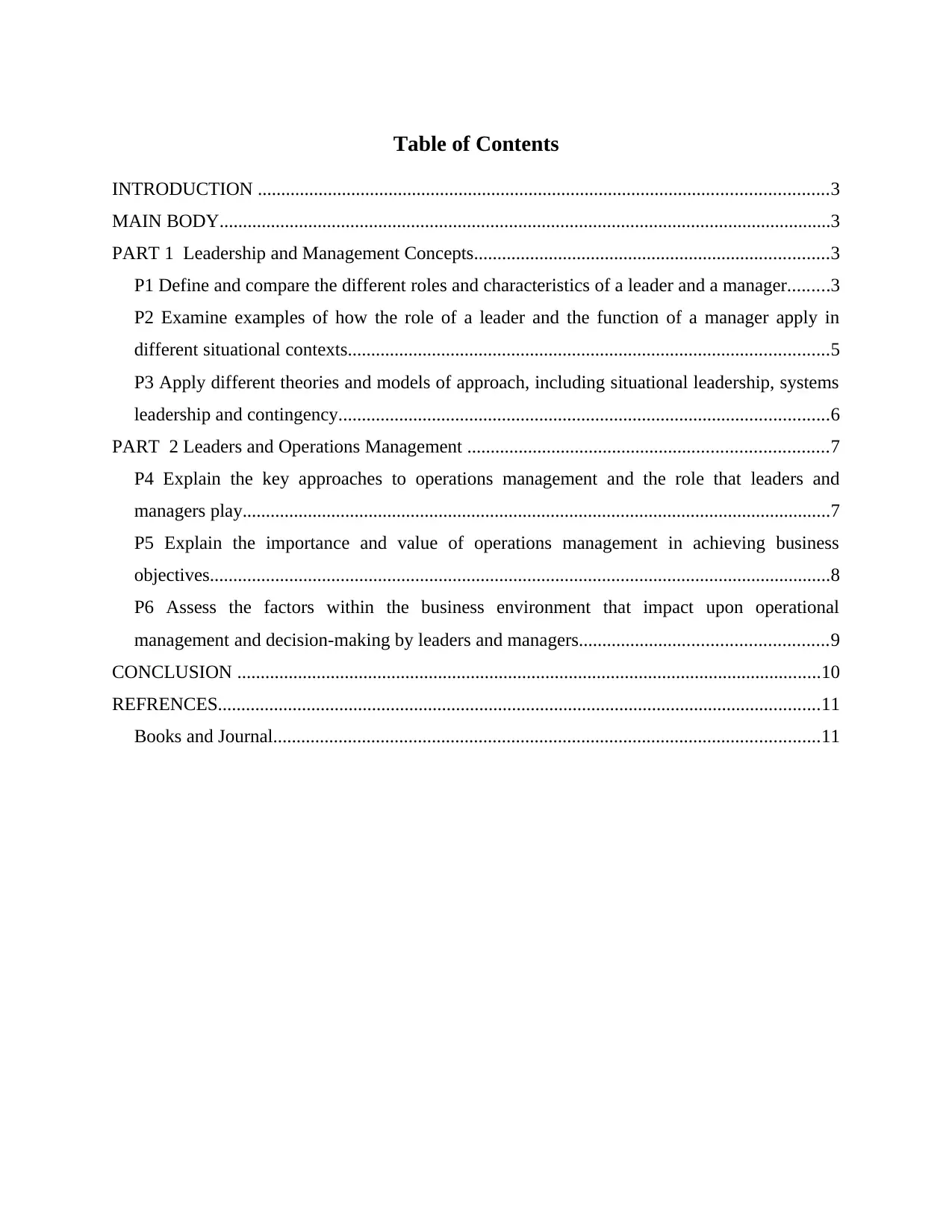
Table of Contents
INTRODUCTION ..........................................................................................................................3
MAIN BODY...................................................................................................................................3
PART 1 Leadership and Management Concepts............................................................................3
P1 Define and compare the different roles and characteristics of a leader and a manager.........3
P2 Examine examples of how the role of a leader and the function of a manager apply in
different situational contexts.......................................................................................................5
P3 Apply different theories and models of approach, including situational leadership, systems
leadership and contingency.........................................................................................................6
PART 2 Leaders and Operations Management .............................................................................7
P4 Explain the key approaches to operations management and the role that leaders and
managers play..............................................................................................................................7
P5 Explain the importance and value of operations management in achieving business
objectives.....................................................................................................................................8
P6 Assess the factors within the business environment that impact upon operational
management and decision-making by leaders and managers.....................................................9
CONCLUSION .............................................................................................................................10
REFRENCES.................................................................................................................................11
Books and Journal.....................................................................................................................11
INTRODUCTION ..........................................................................................................................3
MAIN BODY...................................................................................................................................3
PART 1 Leadership and Management Concepts............................................................................3
P1 Define and compare the different roles and characteristics of a leader and a manager.........3
P2 Examine examples of how the role of a leader and the function of a manager apply in
different situational contexts.......................................................................................................5
P3 Apply different theories and models of approach, including situational leadership, systems
leadership and contingency.........................................................................................................6
PART 2 Leaders and Operations Management .............................................................................7
P4 Explain the key approaches to operations management and the role that leaders and
managers play..............................................................................................................................7
P5 Explain the importance and value of operations management in achieving business
objectives.....................................................................................................................................8
P6 Assess the factors within the business environment that impact upon operational
management and decision-making by leaders and managers.....................................................9
CONCLUSION .............................................................................................................................10
REFRENCES.................................................................................................................................11
Books and Journal.....................................................................................................................11
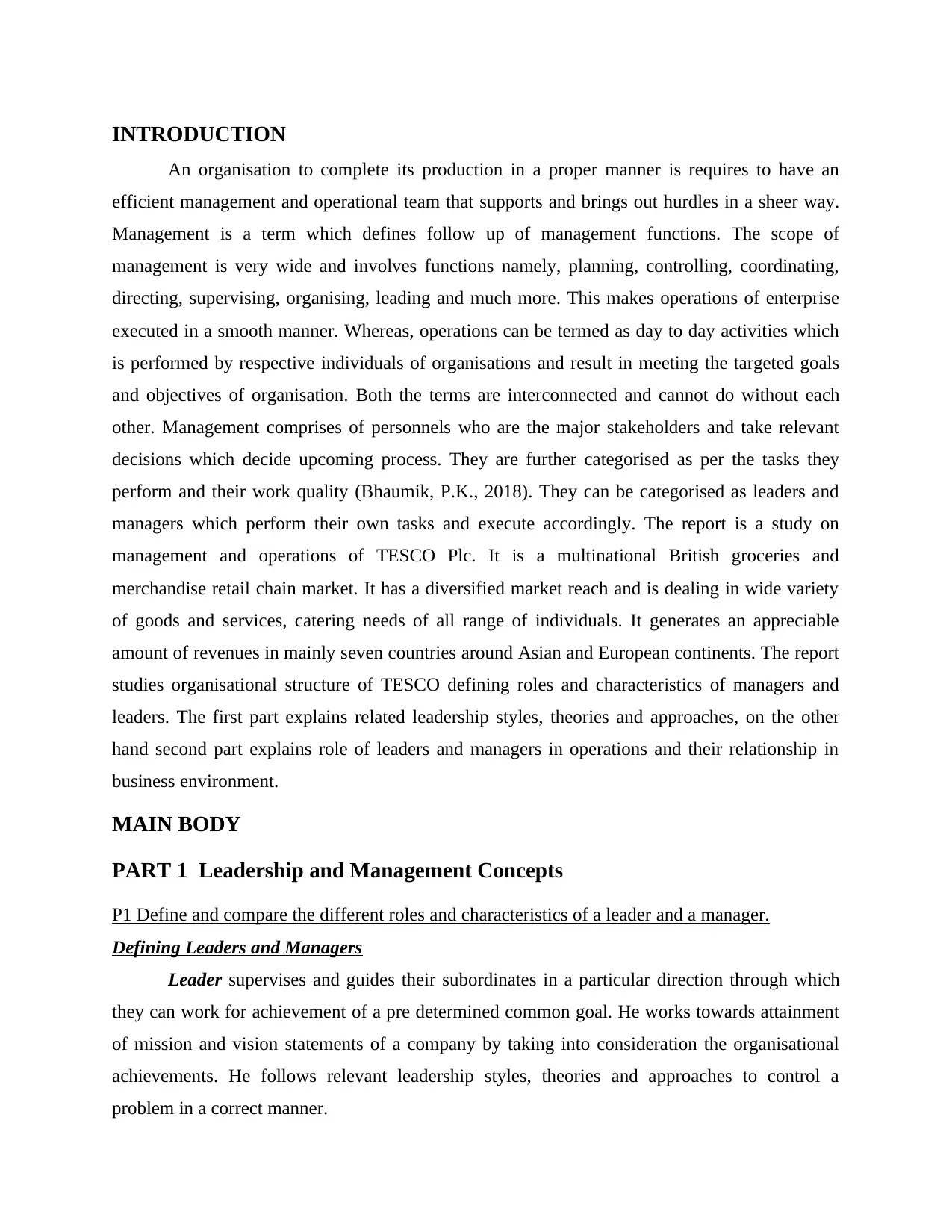
INTRODUCTION
An organisation to complete its production in a proper manner is requires to have an
efficient management and operational team that supports and brings out hurdles in a sheer way.
Management is a term which defines follow up of management functions. The scope of
management is very wide and involves functions namely, planning, controlling, coordinating,
directing, supervising, organising, leading and much more. This makes operations of enterprise
executed in a smooth manner. Whereas, operations can be termed as day to day activities which
is performed by respective individuals of organisations and result in meeting the targeted goals
and objectives of organisation. Both the terms are interconnected and cannot do without each
other. Management comprises of personnels who are the major stakeholders and take relevant
decisions which decide upcoming process. They are further categorised as per the tasks they
perform and their work quality (Bhaumik, P.K., 2018). They can be categorised as leaders and
managers which perform their own tasks and execute accordingly. The report is a study on
management and operations of TESCO Plc. It is a multinational British groceries and
merchandise retail chain market. It has a diversified market reach and is dealing in wide variety
of goods and services, catering needs of all range of individuals. It generates an appreciable
amount of revenues in mainly seven countries around Asian and European continents. The report
studies organisational structure of TESCO defining roles and characteristics of managers and
leaders. The first part explains related leadership styles, theories and approaches, on the other
hand second part explains role of leaders and managers in operations and their relationship in
business environment.
MAIN BODY
PART 1 Leadership and Management Concepts
P1 Define and compare the different roles and characteristics of a leader and a manager.
Defining Leaders and Managers
Leader supervises and guides their subordinates in a particular direction through which
they can work for achievement of a pre determined common goal. He works towards attainment
of mission and vision statements of a company by taking into consideration the organisational
achievements. He follows relevant leadership styles, theories and approaches to control a
problem in a correct manner.
An organisation to complete its production in a proper manner is requires to have an
efficient management and operational team that supports and brings out hurdles in a sheer way.
Management is a term which defines follow up of management functions. The scope of
management is very wide and involves functions namely, planning, controlling, coordinating,
directing, supervising, organising, leading and much more. This makes operations of enterprise
executed in a smooth manner. Whereas, operations can be termed as day to day activities which
is performed by respective individuals of organisations and result in meeting the targeted goals
and objectives of organisation. Both the terms are interconnected and cannot do without each
other. Management comprises of personnels who are the major stakeholders and take relevant
decisions which decide upcoming process. They are further categorised as per the tasks they
perform and their work quality (Bhaumik, P.K., 2018). They can be categorised as leaders and
managers which perform their own tasks and execute accordingly. The report is a study on
management and operations of TESCO Plc. It is a multinational British groceries and
merchandise retail chain market. It has a diversified market reach and is dealing in wide variety
of goods and services, catering needs of all range of individuals. It generates an appreciable
amount of revenues in mainly seven countries around Asian and European continents. The report
studies organisational structure of TESCO defining roles and characteristics of managers and
leaders. The first part explains related leadership styles, theories and approaches, on the other
hand second part explains role of leaders and managers in operations and their relationship in
business environment.
MAIN BODY
PART 1 Leadership and Management Concepts
P1 Define and compare the different roles and characteristics of a leader and a manager.
Defining Leaders and Managers
Leader supervises and guides their subordinates in a particular direction through which
they can work for achievement of a pre determined common goal. He works towards attainment
of mission and vision statements of a company by taking into consideration the organisational
achievements. He follows relevant leadership styles, theories and approaches to control a
problem in a correct manner.
⊘ This is a preview!⊘
Do you want full access?
Subscribe today to unlock all pages.

Trusted by 1+ million students worldwide
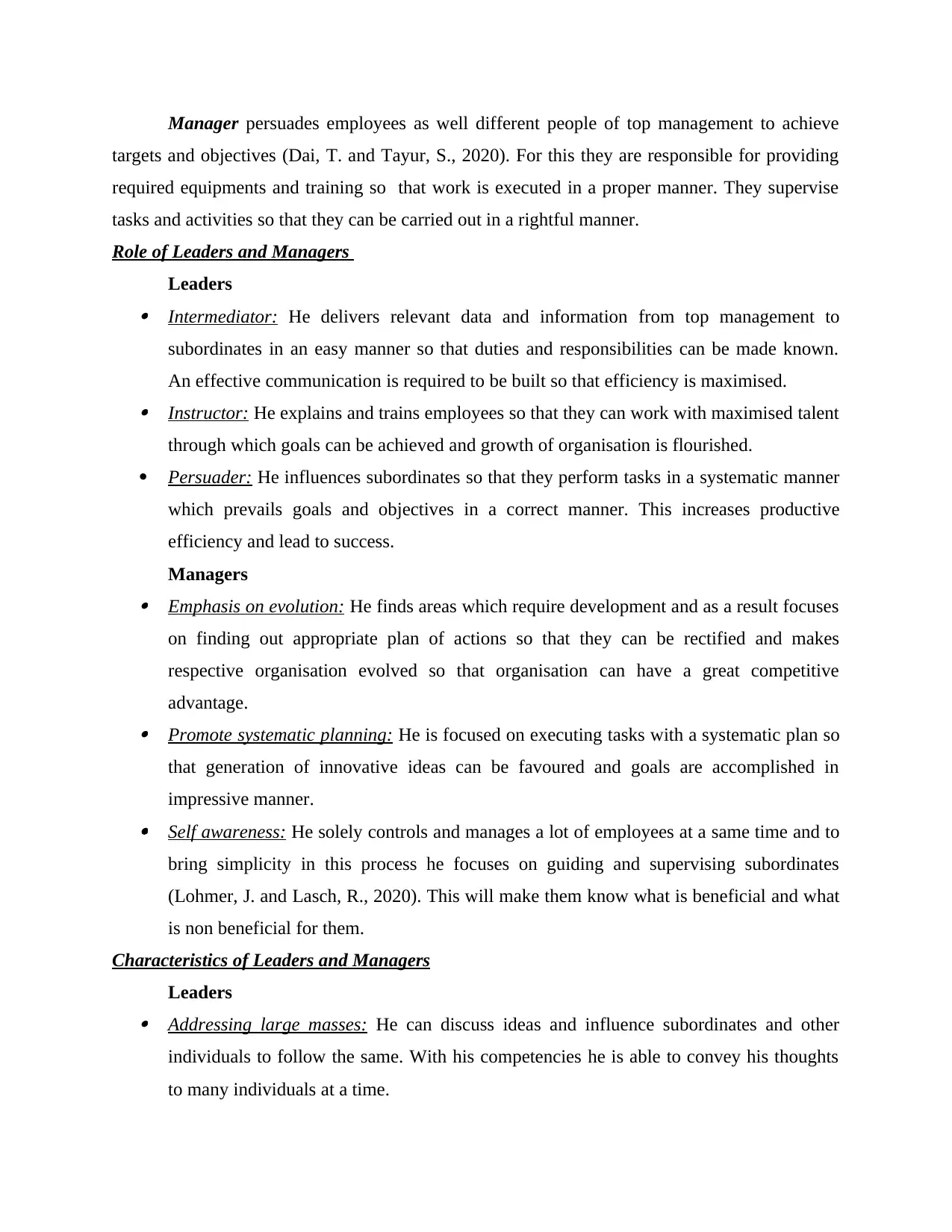
Manager persuades employees as well different people of top management to achieve
targets and objectives (Dai, T. and Tayur, S., 2020). For this they are responsible for providing
required equipments and training so that work is executed in a proper manner. They supervise
tasks and activities so that they can be carried out in a rightful manner.
Role of Leaders and Managers
Leaders Intermediator: He delivers relevant data and information from top management to
subordinates in an easy manner so that duties and responsibilities can be made known.
An effective communication is required to be built so that efficiency is maximised. Instructor: He explains and trains employees so that they can work with maximised talent
through which goals can be achieved and growth of organisation is flourished.
Persuader: He influences subordinates so that they perform tasks in a systematic manner
which prevails goals and objectives in a correct manner. This increases productive
efficiency and lead to success.
Managers Emphasis on evolution: He finds areas which require development and as a result focuses
on finding out appropriate plan of actions so that they can be rectified and makes
respective organisation evolved so that organisation can have a great competitive
advantage. Promote systematic planning: He is focused on executing tasks with a systematic plan so
that generation of innovative ideas can be favoured and goals are accomplished in
impressive manner. Self awareness: He solely controls and manages a lot of employees at a same time and to
bring simplicity in this process he focuses on guiding and supervising subordinates
(Lohmer, J. and Lasch, R., 2020). This will make them know what is beneficial and what
is non beneficial for them.
Characteristics of Leaders and Managers
Leaders Addressing large masses: He can discuss ideas and influence subordinates and other
individuals to follow the same. With his competencies he is able to convey his thoughts
to many individuals at a time.
targets and objectives (Dai, T. and Tayur, S., 2020). For this they are responsible for providing
required equipments and training so that work is executed in a proper manner. They supervise
tasks and activities so that they can be carried out in a rightful manner.
Role of Leaders and Managers
Leaders Intermediator: He delivers relevant data and information from top management to
subordinates in an easy manner so that duties and responsibilities can be made known.
An effective communication is required to be built so that efficiency is maximised. Instructor: He explains and trains employees so that they can work with maximised talent
through which goals can be achieved and growth of organisation is flourished.
Persuader: He influences subordinates so that they perform tasks in a systematic manner
which prevails goals and objectives in a correct manner. This increases productive
efficiency and lead to success.
Managers Emphasis on evolution: He finds areas which require development and as a result focuses
on finding out appropriate plan of actions so that they can be rectified and makes
respective organisation evolved so that organisation can have a great competitive
advantage. Promote systematic planning: He is focused on executing tasks with a systematic plan so
that generation of innovative ideas can be favoured and goals are accomplished in
impressive manner. Self awareness: He solely controls and manages a lot of employees at a same time and to
bring simplicity in this process he focuses on guiding and supervising subordinates
(Lohmer, J. and Lasch, R., 2020). This will make them know what is beneficial and what
is non beneficial for them.
Characteristics of Leaders and Managers
Leaders Addressing large masses: He can discuss ideas and influence subordinates and other
individuals to follow the same. With his competencies he is able to convey his thoughts
to many individuals at a time.
Paraphrase This Document
Need a fresh take? Get an instant paraphrase of this document with our AI Paraphraser
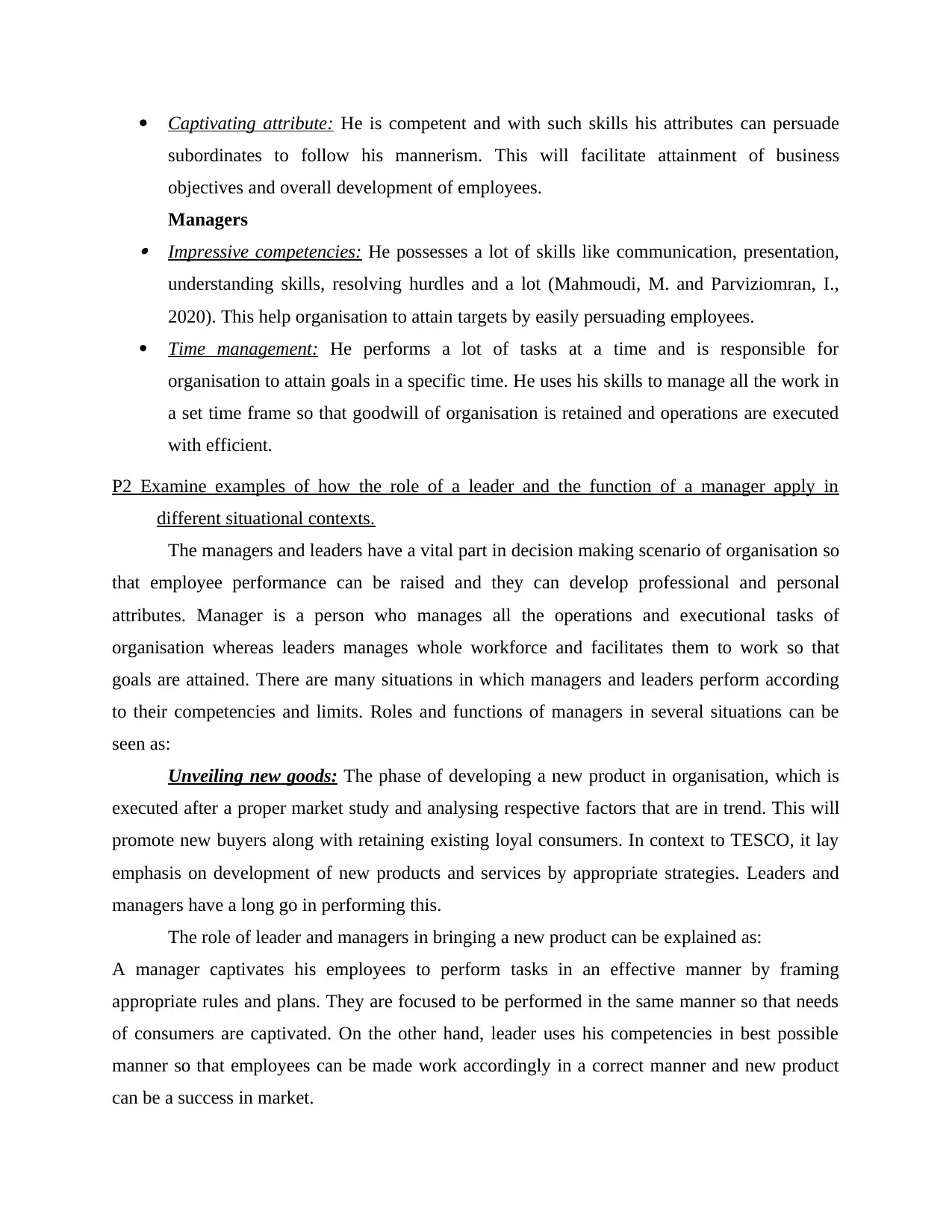
Captivating attribute: He is competent and with such skills his attributes can persuade
subordinates to follow his mannerism. This will facilitate attainment of business
objectives and overall development of employees.
Managers Impressive competencies: He possesses a lot of skills like communication, presentation,
understanding skills, resolving hurdles and a lot (Mahmoudi, M. and Parviziomran, I.,
2020). This help organisation to attain targets by easily persuading employees.
Time management: He performs a lot of tasks at a time and is responsible for
organisation to attain goals in a specific time. He uses his skills to manage all the work in
a set time frame so that goodwill of organisation is retained and operations are executed
with efficient.
P2 Examine examples of how the role of a leader and the function of a manager apply in
different situational contexts.
The managers and leaders have a vital part in decision making scenario of organisation so
that employee performance can be raised and they can develop professional and personal
attributes. Manager is a person who manages all the operations and executional tasks of
organisation whereas leaders manages whole workforce and facilitates them to work so that
goals are attained. There are many situations in which managers and leaders perform according
to their competencies and limits. Roles and functions of managers in several situations can be
seen as:
Unveiling new goods: The phase of developing a new product in organisation, which is
executed after a proper market study and analysing respective factors that are in trend. This will
promote new buyers along with retaining existing loyal consumers. In context to TESCO, it lay
emphasis on development of new products and services by appropriate strategies. Leaders and
managers have a long go in performing this.
The role of leader and managers in bringing a new product can be explained as:
A manager captivates his employees to perform tasks in an effective manner by framing
appropriate rules and plans. They are focused to be performed in the same manner so that needs
of consumers are captivated. On the other hand, leader uses his competencies in best possible
manner so that employees can be made work accordingly in a correct manner and new product
can be a success in market.
subordinates to follow his mannerism. This will facilitate attainment of business
objectives and overall development of employees.
Managers Impressive competencies: He possesses a lot of skills like communication, presentation,
understanding skills, resolving hurdles and a lot (Mahmoudi, M. and Parviziomran, I.,
2020). This help organisation to attain targets by easily persuading employees.
Time management: He performs a lot of tasks at a time and is responsible for
organisation to attain goals in a specific time. He uses his skills to manage all the work in
a set time frame so that goodwill of organisation is retained and operations are executed
with efficient.
P2 Examine examples of how the role of a leader and the function of a manager apply in
different situational contexts.
The managers and leaders have a vital part in decision making scenario of organisation so
that employee performance can be raised and they can develop professional and personal
attributes. Manager is a person who manages all the operations and executional tasks of
organisation whereas leaders manages whole workforce and facilitates them to work so that
goals are attained. There are many situations in which managers and leaders perform according
to their competencies and limits. Roles and functions of managers in several situations can be
seen as:
Unveiling new goods: The phase of developing a new product in organisation, which is
executed after a proper market study and analysing respective factors that are in trend. This will
promote new buyers along with retaining existing loyal consumers. In context to TESCO, it lay
emphasis on development of new products and services by appropriate strategies. Leaders and
managers have a long go in performing this.
The role of leader and managers in bringing a new product can be explained as:
A manager captivates his employees to perform tasks in an effective manner by framing
appropriate rules and plans. They are focused to be performed in the same manner so that needs
of consumers are captivated. On the other hand, leader uses his competencies in best possible
manner so that employees can be made work accordingly in a correct manner and new product
can be a success in market.
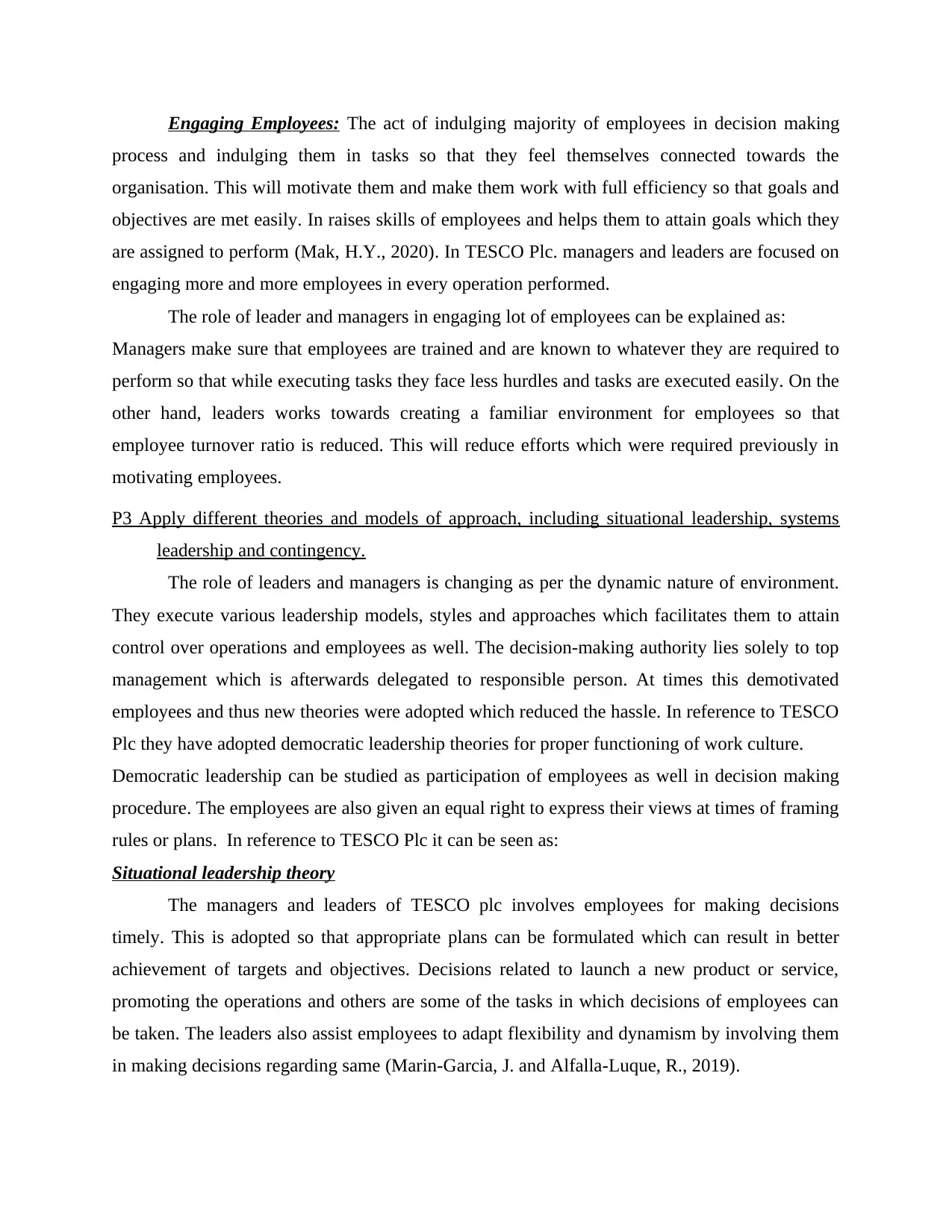
Engaging Employees: The act of indulging majority of employees in decision making
process and indulging them in tasks so that they feel themselves connected towards the
organisation. This will motivate them and make them work with full efficiency so that goals and
objectives are met easily. In raises skills of employees and helps them to attain goals which they
are assigned to perform (Mak, H.Y., 2020). In TESCO Plc. managers and leaders are focused on
engaging more and more employees in every operation performed.
The role of leader and managers in engaging lot of employees can be explained as:
Managers make sure that employees are trained and are known to whatever they are required to
perform so that while executing tasks they face less hurdles and tasks are executed easily. On the
other hand, leaders works towards creating a familiar environment for employees so that
employee turnover ratio is reduced. This will reduce efforts which were required previously in
motivating employees.
P3 Apply different theories and models of approach, including situational leadership, systems
leadership and contingency.
The role of leaders and managers is changing as per the dynamic nature of environment.
They execute various leadership models, styles and approaches which facilitates them to attain
control over operations and employees as well. The decision-making authority lies solely to top
management which is afterwards delegated to responsible person. At times this demotivated
employees and thus new theories were adopted which reduced the hassle. In reference to TESCO
Plc they have adopted democratic leadership theories for proper functioning of work culture.
Democratic leadership can be studied as participation of employees as well in decision making
procedure. The employees are also given an equal right to express their views at times of framing
rules or plans. In reference to TESCO Plc it can be seen as:
Situational leadership theory
The managers and leaders of TESCO plc involves employees for making decisions
timely. This is adopted so that appropriate plans can be formulated which can result in better
achievement of targets and objectives. Decisions related to launch a new product or service,
promoting the operations and others are some of the tasks in which decisions of employees can
be taken. The leaders also assist employees to adapt flexibility and dynamism by involving them
in making decisions regarding same (Marin-Garcia, J. and Alfalla-Luque, R., 2019).
process and indulging them in tasks so that they feel themselves connected towards the
organisation. This will motivate them and make them work with full efficiency so that goals and
objectives are met easily. In raises skills of employees and helps them to attain goals which they
are assigned to perform (Mak, H.Y., 2020). In TESCO Plc. managers and leaders are focused on
engaging more and more employees in every operation performed.
The role of leader and managers in engaging lot of employees can be explained as:
Managers make sure that employees are trained and are known to whatever they are required to
perform so that while executing tasks they face less hurdles and tasks are executed easily. On the
other hand, leaders works towards creating a familiar environment for employees so that
employee turnover ratio is reduced. This will reduce efforts which were required previously in
motivating employees.
P3 Apply different theories and models of approach, including situational leadership, systems
leadership and contingency.
The role of leaders and managers is changing as per the dynamic nature of environment.
They execute various leadership models, styles and approaches which facilitates them to attain
control over operations and employees as well. The decision-making authority lies solely to top
management which is afterwards delegated to responsible person. At times this demotivated
employees and thus new theories were adopted which reduced the hassle. In reference to TESCO
Plc they have adopted democratic leadership theories for proper functioning of work culture.
Democratic leadership can be studied as participation of employees as well in decision making
procedure. The employees are also given an equal right to express their views at times of framing
rules or plans. In reference to TESCO Plc it can be seen as:
Situational leadership theory
The managers and leaders of TESCO plc involves employees for making decisions
timely. This is adopted so that appropriate plans can be formulated which can result in better
achievement of targets and objectives. Decisions related to launch a new product or service,
promoting the operations and others are some of the tasks in which decisions of employees can
be taken. The leaders also assist employees to adapt flexibility and dynamism by involving them
in making decisions regarding same (Marin-Garcia, J. and Alfalla-Luque, R., 2019).
⊘ This is a preview!⊘
Do you want full access?
Subscribe today to unlock all pages.

Trusted by 1+ million students worldwide
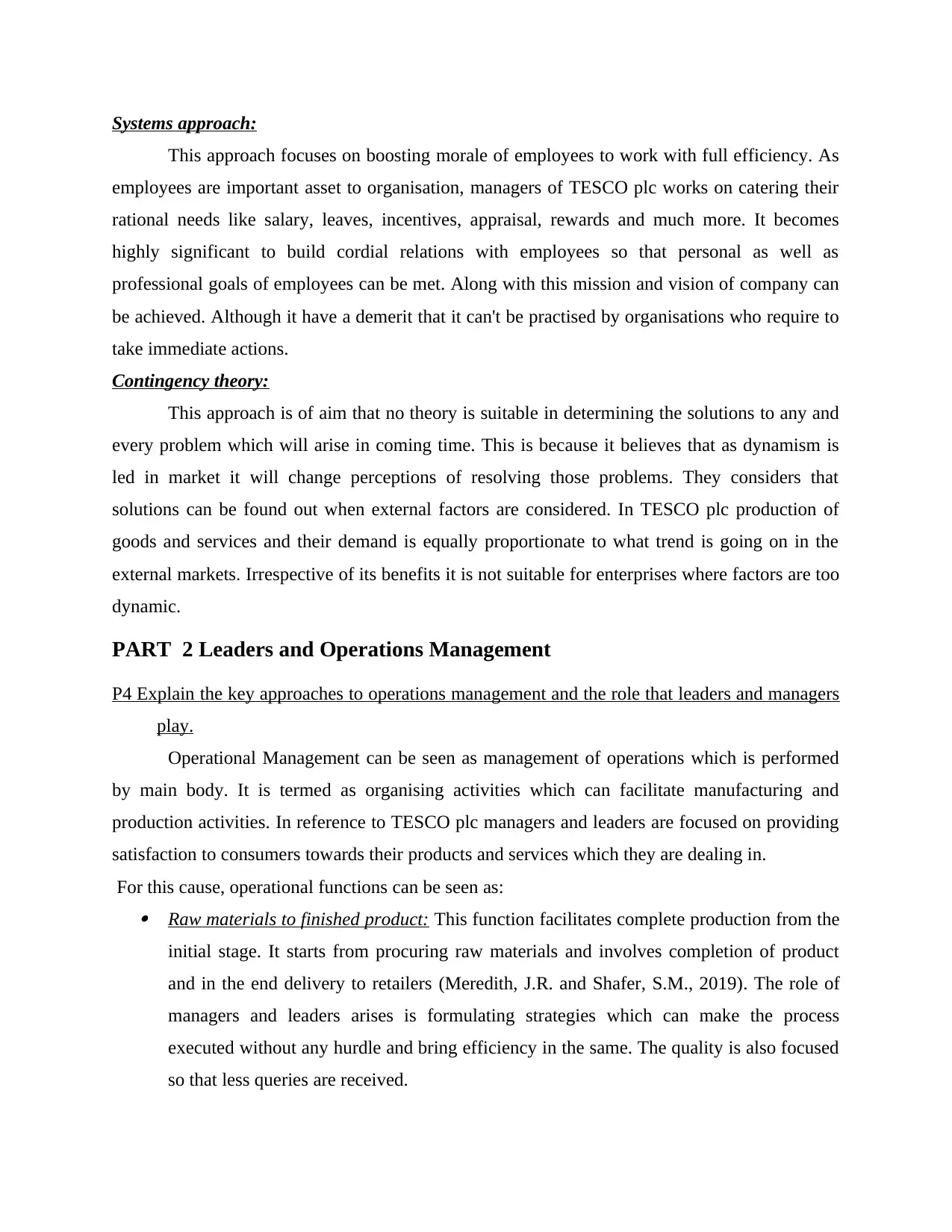
Systems approach:
This approach focuses on boosting morale of employees to work with full efficiency. As
employees are important asset to organisation, managers of TESCO plc works on catering their
rational needs like salary, leaves, incentives, appraisal, rewards and much more. It becomes
highly significant to build cordial relations with employees so that personal as well as
professional goals of employees can be met. Along with this mission and vision of company can
be achieved. Although it have a demerit that it can't be practised by organisations who require to
take immediate actions.
Contingency theory:
This approach is of aim that no theory is suitable in determining the solutions to any and
every problem which will arise in coming time. This is because it believes that as dynamism is
led in market it will change perceptions of resolving those problems. They considers that
solutions can be found out when external factors are considered. In TESCO plc production of
goods and services and their demand is equally proportionate to what trend is going on in the
external markets. Irrespective of its benefits it is not suitable for enterprises where factors are too
dynamic.
PART 2 Leaders and Operations Management
P4 Explain the key approaches to operations management and the role that leaders and managers
play.
Operational Management can be seen as management of operations which is performed
by main body. It is termed as organising activities which can facilitate manufacturing and
production activities. In reference to TESCO plc managers and leaders are focused on providing
satisfaction to consumers towards their products and services which they are dealing in.
For this cause, operational functions can be seen as: Raw materials to finished product: This function facilitates complete production from the
initial stage. It starts from procuring raw materials and involves completion of product
and in the end delivery to retailers (Meredith, J.R. and Shafer, S.M., 2019). The role of
managers and leaders arises is formulating strategies which can make the process
executed without any hurdle and bring efficiency in the same. The quality is also focused
so that less queries are received.
This approach focuses on boosting morale of employees to work with full efficiency. As
employees are important asset to organisation, managers of TESCO plc works on catering their
rational needs like salary, leaves, incentives, appraisal, rewards and much more. It becomes
highly significant to build cordial relations with employees so that personal as well as
professional goals of employees can be met. Along with this mission and vision of company can
be achieved. Although it have a demerit that it can't be practised by organisations who require to
take immediate actions.
Contingency theory:
This approach is of aim that no theory is suitable in determining the solutions to any and
every problem which will arise in coming time. This is because it believes that as dynamism is
led in market it will change perceptions of resolving those problems. They considers that
solutions can be found out when external factors are considered. In TESCO plc production of
goods and services and their demand is equally proportionate to what trend is going on in the
external markets. Irrespective of its benefits it is not suitable for enterprises where factors are too
dynamic.
PART 2 Leaders and Operations Management
P4 Explain the key approaches to operations management and the role that leaders and managers
play.
Operational Management can be seen as management of operations which is performed
by main body. It is termed as organising activities which can facilitate manufacturing and
production activities. In reference to TESCO plc managers and leaders are focused on providing
satisfaction to consumers towards their products and services which they are dealing in.
For this cause, operational functions can be seen as: Raw materials to finished product: This function facilitates complete production from the
initial stage. It starts from procuring raw materials and involves completion of product
and in the end delivery to retailers (Meredith, J.R. and Shafer, S.M., 2019). The role of
managers and leaders arises is formulating strategies which can make the process
executed without any hurdle and bring efficiency in the same. The quality is also focused
so that less queries are received.
Paraphrase This Document
Need a fresh take? Get an instant paraphrase of this document with our AI Paraphraser
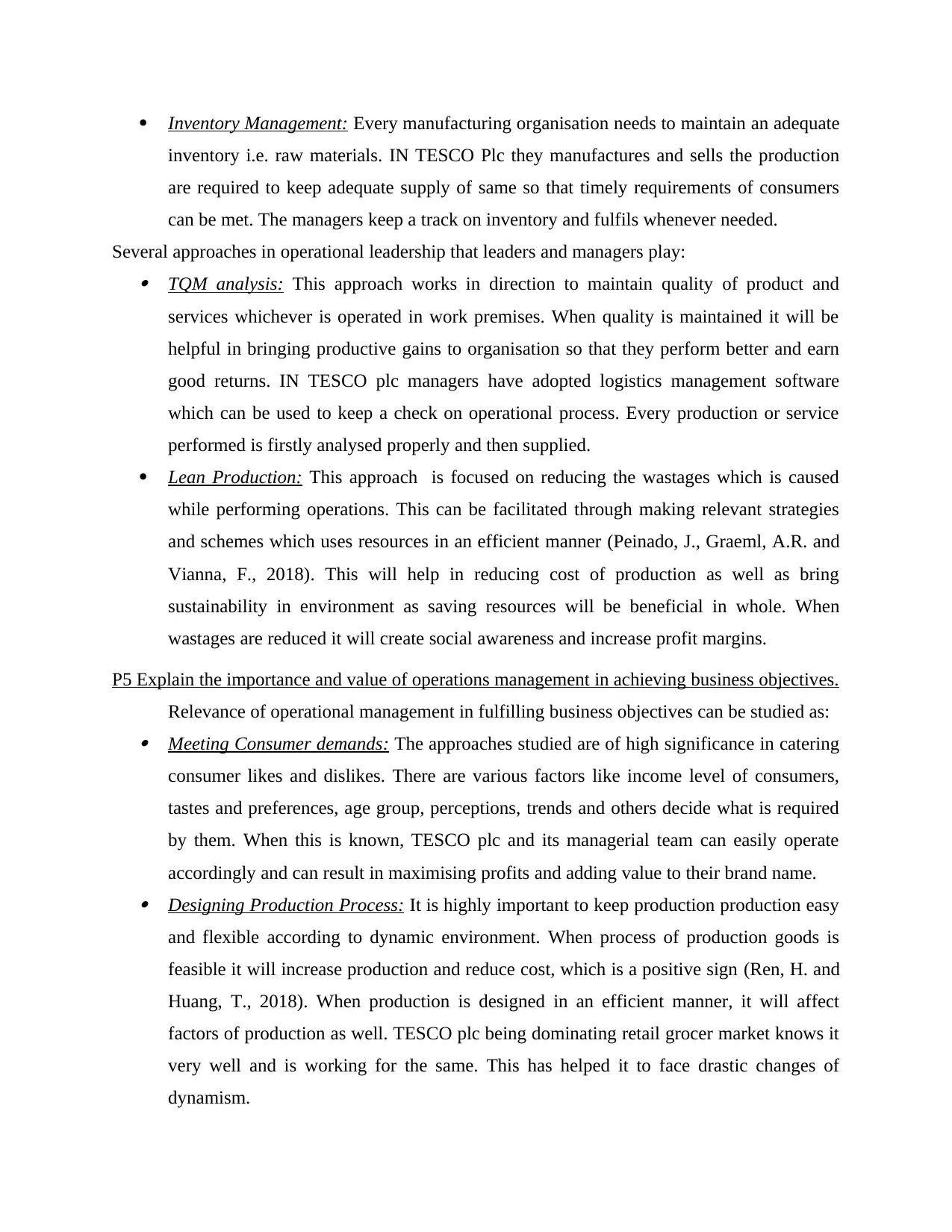
Inventory Management: Every manufacturing organisation needs to maintain an adequate
inventory i.e. raw materials. IN TESCO Plc they manufactures and sells the production
are required to keep adequate supply of same so that timely requirements of consumers
can be met. The managers keep a track on inventory and fulfils whenever needed.
Several approaches in operational leadership that leaders and managers play: TQM analysis: This approach works in direction to maintain quality of product and
services whichever is operated in work premises. When quality is maintained it will be
helpful in bringing productive gains to organisation so that they perform better and earn
good returns. IN TESCO plc managers have adopted logistics management software
which can be used to keep a check on operational process. Every production or service
performed is firstly analysed properly and then supplied.
Lean Production: This approach is focused on reducing the wastages which is caused
while performing operations. This can be facilitated through making relevant strategies
and schemes which uses resources in an efficient manner (Peinado, J., Graeml, A.R. and
Vianna, F., 2018). This will help in reducing cost of production as well as bring
sustainability in environment as saving resources will be beneficial in whole. When
wastages are reduced it will create social awareness and increase profit margins.
P5 Explain the importance and value of operations management in achieving business objectives.
Relevance of operational management in fulfilling business objectives can be studied as: Meeting Consumer demands: The approaches studied are of high significance in catering
consumer likes and dislikes. There are various factors like income level of consumers,
tastes and preferences, age group, perceptions, trends and others decide what is required
by them. When this is known, TESCO plc and its managerial team can easily operate
accordingly and can result in maximising profits and adding value to their brand name. Designing Production Process: It is highly important to keep production production easy
and flexible according to dynamic environment. When process of production goods is
feasible it will increase production and reduce cost, which is a positive sign (Ren, H. and
Huang, T., 2018). When production is designed in an efficient manner, it will affect
factors of production as well. TESCO plc being dominating retail grocer market knows it
very well and is working for the same. This has helped it to face drastic changes of
dynamism.
inventory i.e. raw materials. IN TESCO Plc they manufactures and sells the production
are required to keep adequate supply of same so that timely requirements of consumers
can be met. The managers keep a track on inventory and fulfils whenever needed.
Several approaches in operational leadership that leaders and managers play: TQM analysis: This approach works in direction to maintain quality of product and
services whichever is operated in work premises. When quality is maintained it will be
helpful in bringing productive gains to organisation so that they perform better and earn
good returns. IN TESCO plc managers have adopted logistics management software
which can be used to keep a check on operational process. Every production or service
performed is firstly analysed properly and then supplied.
Lean Production: This approach is focused on reducing the wastages which is caused
while performing operations. This can be facilitated through making relevant strategies
and schemes which uses resources in an efficient manner (Peinado, J., Graeml, A.R. and
Vianna, F., 2018). This will help in reducing cost of production as well as bring
sustainability in environment as saving resources will be beneficial in whole. When
wastages are reduced it will create social awareness and increase profit margins.
P5 Explain the importance and value of operations management in achieving business objectives.
Relevance of operational management in fulfilling business objectives can be studied as: Meeting Consumer demands: The approaches studied are of high significance in catering
consumer likes and dislikes. There are various factors like income level of consumers,
tastes and preferences, age group, perceptions, trends and others decide what is required
by them. When this is known, TESCO plc and its managerial team can easily operate
accordingly and can result in maximising profits and adding value to their brand name. Designing Production Process: It is highly important to keep production production easy
and flexible according to dynamic environment. When process of production goods is
feasible it will increase production and reduce cost, which is a positive sign (Ren, H. and
Huang, T., 2018). When production is designed in an efficient manner, it will affect
factors of production as well. TESCO plc being dominating retail grocer market knows it
very well and is working for the same. This has helped it to face drastic changes of
dynamism.
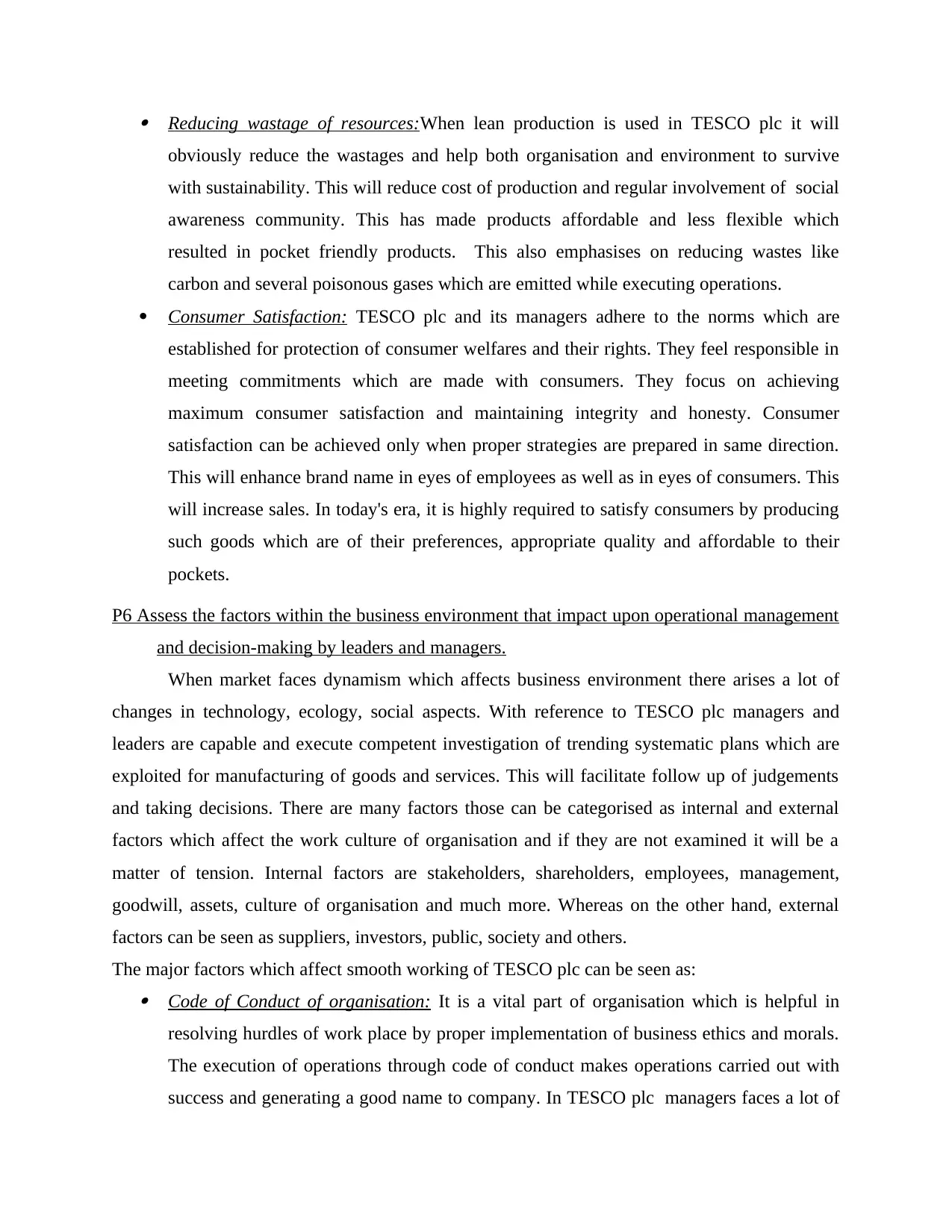
Reducing wastage of resources:When lean production is used in TESCO plc it will
obviously reduce the wastages and help both organisation and environment to survive
with sustainability. This will reduce cost of production and regular involvement of social
awareness community. This has made products affordable and less flexible which
resulted in pocket friendly products. This also emphasises on reducing wastes like
carbon and several poisonous gases which are emitted while executing operations.
Consumer Satisfaction: TESCO plc and its managers adhere to the norms which are
established for protection of consumer welfares and their rights. They feel responsible in
meeting commitments which are made with consumers. They focus on achieving
maximum consumer satisfaction and maintaining integrity and honesty. Consumer
satisfaction can be achieved only when proper strategies are prepared in same direction.
This will enhance brand name in eyes of employees as well as in eyes of consumers. This
will increase sales. In today's era, it is highly required to satisfy consumers by producing
such goods which are of their preferences, appropriate quality and affordable to their
pockets.
P6 Assess the factors within the business environment that impact upon operational management
and decision-making by leaders and managers.
When market faces dynamism which affects business environment there arises a lot of
changes in technology, ecology, social aspects. With reference to TESCO plc managers and
leaders are capable and execute competent investigation of trending systematic plans which are
exploited for manufacturing of goods and services. This will facilitate follow up of judgements
and taking decisions. There are many factors those can be categorised as internal and external
factors which affect the work culture of organisation and if they are not examined it will be a
matter of tension. Internal factors are stakeholders, shareholders, employees, management,
goodwill, assets, culture of organisation and much more. Whereas on the other hand, external
factors can be seen as suppliers, investors, public, society and others.
The major factors which affect smooth working of TESCO plc can be seen as: Code of Conduct of organisation: It is a vital part of organisation which is helpful in
resolving hurdles of work place by proper implementation of business ethics and morals.
The execution of operations through code of conduct makes operations carried out with
success and generating a good name to company. In TESCO plc managers faces a lot of
obviously reduce the wastages and help both organisation and environment to survive
with sustainability. This will reduce cost of production and regular involvement of social
awareness community. This has made products affordable and less flexible which
resulted in pocket friendly products. This also emphasises on reducing wastes like
carbon and several poisonous gases which are emitted while executing operations.
Consumer Satisfaction: TESCO plc and its managers adhere to the norms which are
established for protection of consumer welfares and their rights. They feel responsible in
meeting commitments which are made with consumers. They focus on achieving
maximum consumer satisfaction and maintaining integrity and honesty. Consumer
satisfaction can be achieved only when proper strategies are prepared in same direction.
This will enhance brand name in eyes of employees as well as in eyes of consumers. This
will increase sales. In today's era, it is highly required to satisfy consumers by producing
such goods which are of their preferences, appropriate quality and affordable to their
pockets.
P6 Assess the factors within the business environment that impact upon operational management
and decision-making by leaders and managers.
When market faces dynamism which affects business environment there arises a lot of
changes in technology, ecology, social aspects. With reference to TESCO plc managers and
leaders are capable and execute competent investigation of trending systematic plans which are
exploited for manufacturing of goods and services. This will facilitate follow up of judgements
and taking decisions. There are many factors those can be categorised as internal and external
factors which affect the work culture of organisation and if they are not examined it will be a
matter of tension. Internal factors are stakeholders, shareholders, employees, management,
goodwill, assets, culture of organisation and much more. Whereas on the other hand, external
factors can be seen as suppliers, investors, public, society and others.
The major factors which affect smooth working of TESCO plc can be seen as: Code of Conduct of organisation: It is a vital part of organisation which is helpful in
resolving hurdles of work place by proper implementation of business ethics and morals.
The execution of operations through code of conduct makes operations carried out with
success and generating a good name to company. In TESCO plc managers faces a lot of
⊘ This is a preview!⊘
Do you want full access?
Subscribe today to unlock all pages.

Trusted by 1+ million students worldwide
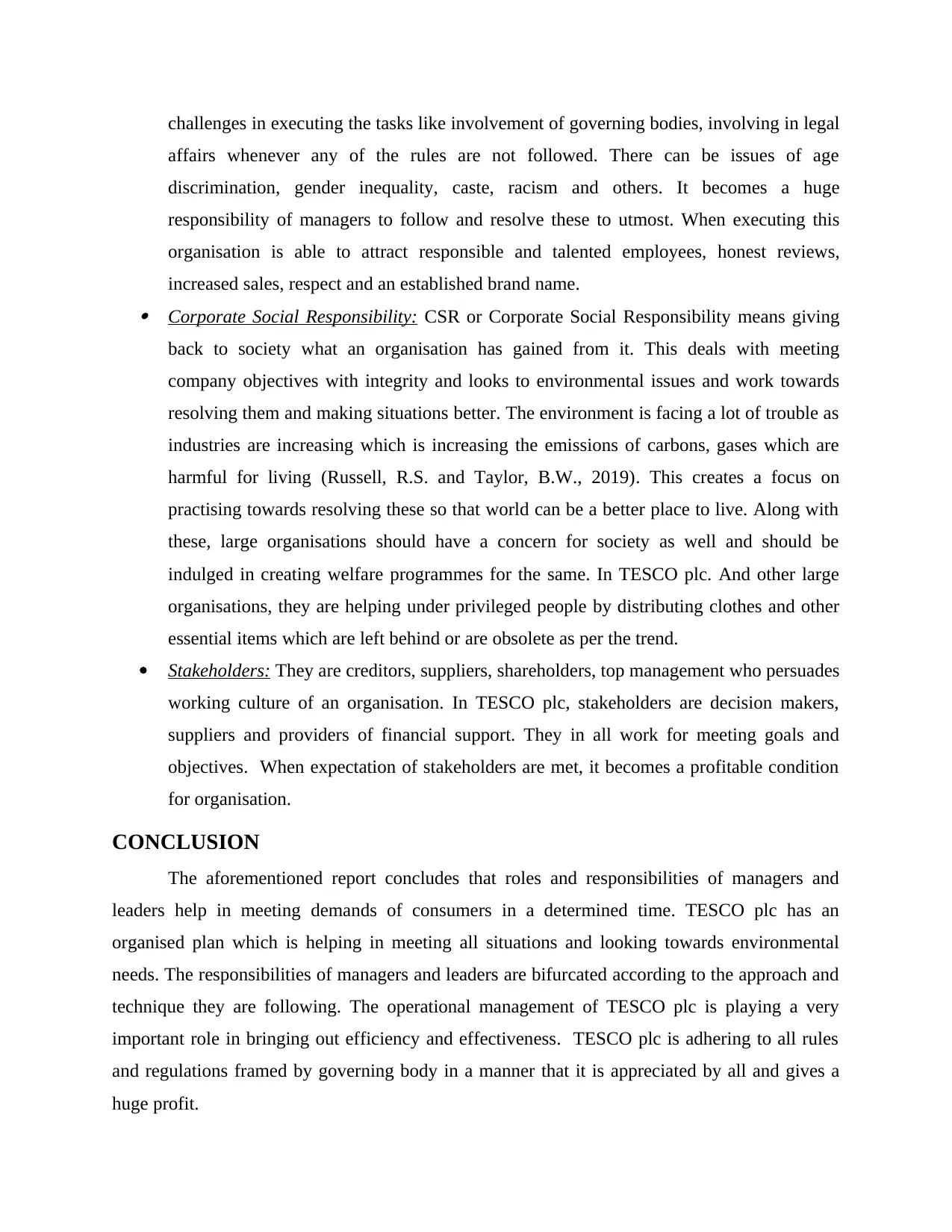
challenges in executing the tasks like involvement of governing bodies, involving in legal
affairs whenever any of the rules are not followed. There can be issues of age
discrimination, gender inequality, caste, racism and others. It becomes a huge
responsibility of managers to follow and resolve these to utmost. When executing this
organisation is able to attract responsible and talented employees, honest reviews,
increased sales, respect and an established brand name. Corporate Social Responsibility: CSR or Corporate Social Responsibility means giving
back to society what an organisation has gained from it. This deals with meeting
company objectives with integrity and looks to environmental issues and work towards
resolving them and making situations better. The environment is facing a lot of trouble as
industries are increasing which is increasing the emissions of carbons, gases which are
harmful for living (Russell, R.S. and Taylor, B.W., 2019). This creates a focus on
practising towards resolving these so that world can be a better place to live. Along with
these, large organisations should have a concern for society as well and should be
indulged in creating welfare programmes for the same. In TESCO plc. And other large
organisations, they are helping under privileged people by distributing clothes and other
essential items which are left behind or are obsolete as per the trend.
Stakeholders: They are creditors, suppliers, shareholders, top management who persuades
working culture of an organisation. In TESCO plc, stakeholders are decision makers,
suppliers and providers of financial support. They in all work for meeting goals and
objectives. When expectation of stakeholders are met, it becomes a profitable condition
for organisation.
CONCLUSION
The aforementioned report concludes that roles and responsibilities of managers and
leaders help in meeting demands of consumers in a determined time. TESCO plc has an
organised plan which is helping in meeting all situations and looking towards environmental
needs. The responsibilities of managers and leaders are bifurcated according to the approach and
technique they are following. The operational management of TESCO plc is playing a very
important role in bringing out efficiency and effectiveness. TESCO plc is adhering to all rules
and regulations framed by governing body in a manner that it is appreciated by all and gives a
huge profit.
affairs whenever any of the rules are not followed. There can be issues of age
discrimination, gender inequality, caste, racism and others. It becomes a huge
responsibility of managers to follow and resolve these to utmost. When executing this
organisation is able to attract responsible and talented employees, honest reviews,
increased sales, respect and an established brand name. Corporate Social Responsibility: CSR or Corporate Social Responsibility means giving
back to society what an organisation has gained from it. This deals with meeting
company objectives with integrity and looks to environmental issues and work towards
resolving them and making situations better. The environment is facing a lot of trouble as
industries are increasing which is increasing the emissions of carbons, gases which are
harmful for living (Russell, R.S. and Taylor, B.W., 2019). This creates a focus on
practising towards resolving these so that world can be a better place to live. Along with
these, large organisations should have a concern for society as well and should be
indulged in creating welfare programmes for the same. In TESCO plc. And other large
organisations, they are helping under privileged people by distributing clothes and other
essential items which are left behind or are obsolete as per the trend.
Stakeholders: They are creditors, suppliers, shareholders, top management who persuades
working culture of an organisation. In TESCO plc, stakeholders are decision makers,
suppliers and providers of financial support. They in all work for meeting goals and
objectives. When expectation of stakeholders are met, it becomes a profitable condition
for organisation.
CONCLUSION
The aforementioned report concludes that roles and responsibilities of managers and
leaders help in meeting demands of consumers in a determined time. TESCO plc has an
organised plan which is helping in meeting all situations and looking towards environmental
needs. The responsibilities of managers and leaders are bifurcated according to the approach and
technique they are following. The operational management of TESCO plc is playing a very
important role in bringing out efficiency and effectiveness. TESCO plc is adhering to all rules
and regulations framed by governing body in a manner that it is appreciated by all and gives a
huge profit.
Paraphrase This Document
Need a fresh take? Get an instant paraphrase of this document with our AI Paraphraser
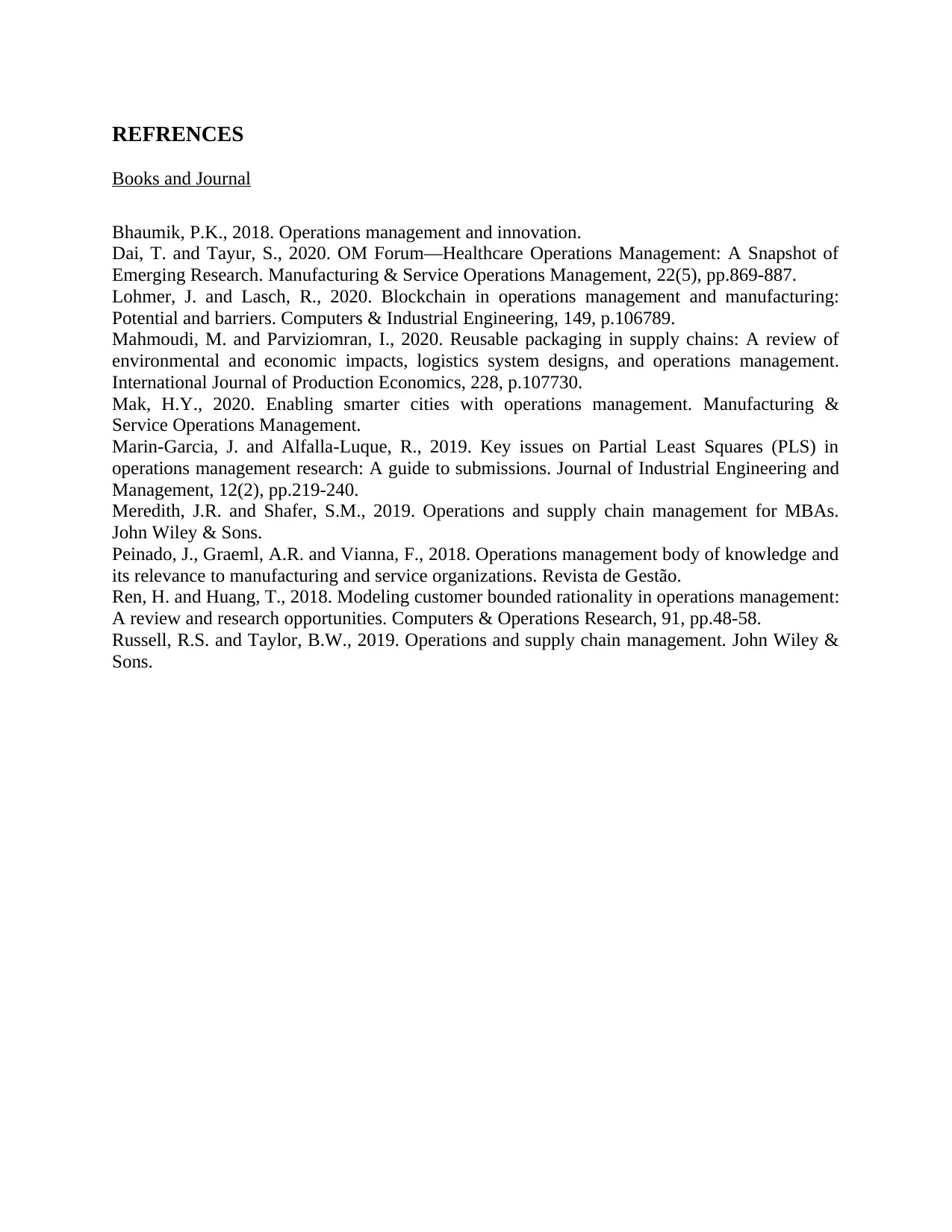
REFRENCES
Books and Journal
Bhaumik, P.K., 2018. Operations management and innovation.
Dai, T. and Tayur, S., 2020. OM Forum—Healthcare Operations Management: A Snapshot of
Emerging Research. Manufacturing & Service Operations Management, 22(5), pp.869-887.
Lohmer, J. and Lasch, R., 2020. Blockchain in operations management and manufacturing:
Potential and barriers. Computers & Industrial Engineering, 149, p.106789.
Mahmoudi, M. and Parviziomran, I., 2020. Reusable packaging in supply chains: A review of
environmental and economic impacts, logistics system designs, and operations management.
International Journal of Production Economics, 228, p.107730.
Mak, H.Y., 2020. Enabling smarter cities with operations management. Manufacturing &
Service Operations Management.
Marin-Garcia, J. and Alfalla-Luque, R., 2019. Key issues on Partial Least Squares (PLS) in
operations management research: A guide to submissions. Journal of Industrial Engineering and
Management, 12(2), pp.219-240.
Meredith, J.R. and Shafer, S.M., 2019. Operations and supply chain management for MBAs.
John Wiley & Sons.
Peinado, J., Graeml, A.R. and Vianna, F., 2018. Operations management body of knowledge and
its relevance to manufacturing and service organizations. Revista de Gestão.
Ren, H. and Huang, T., 2018. Modeling customer bounded rationality in operations management:
A review and research opportunities. Computers & Operations Research, 91, pp.48-58.
Russell, R.S. and Taylor, B.W., 2019. Operations and supply chain management. John Wiley &
Sons.
Books and Journal
Bhaumik, P.K., 2018. Operations management and innovation.
Dai, T. and Tayur, S., 2020. OM Forum—Healthcare Operations Management: A Snapshot of
Emerging Research. Manufacturing & Service Operations Management, 22(5), pp.869-887.
Lohmer, J. and Lasch, R., 2020. Blockchain in operations management and manufacturing:
Potential and barriers. Computers & Industrial Engineering, 149, p.106789.
Mahmoudi, M. and Parviziomran, I., 2020. Reusable packaging in supply chains: A review of
environmental and economic impacts, logistics system designs, and operations management.
International Journal of Production Economics, 228, p.107730.
Mak, H.Y., 2020. Enabling smarter cities with operations management. Manufacturing &
Service Operations Management.
Marin-Garcia, J. and Alfalla-Luque, R., 2019. Key issues on Partial Least Squares (PLS) in
operations management research: A guide to submissions. Journal of Industrial Engineering and
Management, 12(2), pp.219-240.
Meredith, J.R. and Shafer, S.M., 2019. Operations and supply chain management for MBAs.
John Wiley & Sons.
Peinado, J., Graeml, A.R. and Vianna, F., 2018. Operations management body of knowledge and
its relevance to manufacturing and service organizations. Revista de Gestão.
Ren, H. and Huang, T., 2018. Modeling customer bounded rationality in operations management:
A review and research opportunities. Computers & Operations Research, 91, pp.48-58.
Russell, R.S. and Taylor, B.W., 2019. Operations and supply chain management. John Wiley &
Sons.
1 out of 11
Related Documents
Your All-in-One AI-Powered Toolkit for Academic Success.
+13062052269
info@desklib.com
Available 24*7 on WhatsApp / Email
![[object Object]](/_next/static/media/star-bottom.7253800d.svg)
Unlock your academic potential
Copyright © 2020–2025 A2Z Services. All Rights Reserved. Developed and managed by ZUCOL.




